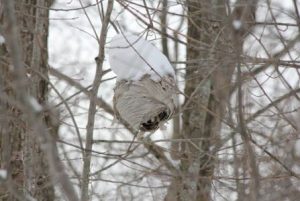

Seek Shelter
Bees and many other insects seek shelter during the colder temperatures to survive. Bees spend the winter as a colony, staying in their hive in what is known as a winter cluster once the temperatures drop below 50 degrees, says Bees-Online. The bees huddle together with the queen in the center, shivering and staying close together for warmth.
While bees, wasps, ladybugs and some other insects seek shelter at high elevations, such as the attics and eaves of homes, barns and buildings, other types of insects, like ants, go low to wait out the winter. Insects may go under the soil, inside logs and trees, under rocks or under decomposing leaves in the search of a suitable winter home.
There are also many types of insects, including cockroaches and beetles, that cannot survive harsh winter temperatures and seek shelter in homes or buildings instead. Homeowners often experience an increase in unwanted pests as the temperatures drop.
Go Dormant
Some insects, such as the emerald ash borer, woolly bear caterpillars and goldenrod gall flies, enter a state of semi-frozen dormancy known as diapause, says Business Insider. In this state, they are in suspended animation and their activities are very limited, but their metabolic rate is high enough to keep them alive.
Wait Out the Winter as Eggs or Immature Insects
A few types of insects can’t survive the winter temperatures, but they leave behind new generations that can. Insects like the praying mantis and corn rootworms lay eggs which can survive the winter. Other insects wait out the winter as larvae in the soil. Moths survive the winter in the pupal stage and enter the world as adults come spring.
Migrate
Certain insects, such as butterflies, avoid the harsh winter temperatures through migration to warmer areas. The migration of monarch butterflies is well documented and known, though other insects may also migrate to warmer or more temperature-stable areas within their habitat zone. Aquatic insects, for example, head towards the bottom of ponds or lakes where the temperature remains higher during the winter.
Business as Usual
In some cases, winter means business as usual for insects. Mites and some types of spiders, for instance, may be found within pockets in the soil or even on the surface of the ground even in the winter. Termites are still active in winter, but go deeper underground. Some species, such as dragonflies, mayflies, and stoneflies, survive the winter as nymphs. The nymphs stay active in winter and survive in the water of ponds and lakes under the ice.
Most insects don’t disappear in winter, and many may find a warm solace inside your home. At Stewart Termite and Pest Control, we can evict these unwanted pests that sneak in when the seasons change. To find out more or to discuss your situation, call us at 800-953-3464 and get a free estimate today.

